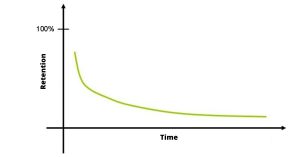Flattening the Forgetting Curve with Engaging Content and Spaced Repetition
In the corporate and business world, staff training initiatives can have a range of different objectives. Effectively and efficiently onboarding new employees is one example. Ensuring compliance with regulations is another. However, one of the most important objectives of training initiatives and strategies is to change long-term employee behaviour.
In your efforts to change employee behaviour to help the company achieve its goals, the Forgetting Curve is your opponent, working against what you are trying to achieve. This applies whether you use e-learning to deliver training to your team, or you use another training delivery method.
Therefore, overcoming the Forgetting Curve, or flattening it, is essential.
Forgetful Learners
Before going into techniques to flatten the Forgetting Curve, let’s first explore what it means.
We have all had experiences where we learn something but then forget it very soon afterwards. In some situations, it only takes a few minutes for the memory to fade.
We can experience this natural forgetfulness during day-to-day activities, such as learning a person’s name and then almost immediately forgetting it. This experience of forgetting newly learned information also applies in formal learning situations.
It can be demoralising when planning new training courses, strategies, and initiatives when you think about how easy it is to forget things we have just learned. Viewed from the most pessimistic of perspectives, what’s the point of doing the training if most of your learners are going to forget most of the information in a short period of time anyway?
The Forgetting Curve is not fixed, however, which means it can be flattened. In other words, there are techniques you can use to improve knowledge retention to make your training courses more effective at changing the long-term behaviour of employees.
So, there is a point in creating new training for employees, particularly if you are using e-learning as the delivery method.
Let’s explore the Forgetting Curve further as well as the steps you can take to mitigate it.
The Forgetting Curve
The Forgetting Curve is a concept developed in the mid-1880s by Hermann Ebbinghaus, a German psychologist who specialised in memory.
According to the Forgetting Curve, the more time that passes where we don’t use or have cause to recall something we have learned, the more likely we are to forget it.
Plus, the curve doesn’t drop down gradually, either. Instead, it is a steep and rapid decline.
This steep reduction in memory demonstrated by the Forgetting Curve shows that many learners will forget about 90 percent of what they have learned within one month of learning it – if they have no reason to recall the information.
Of course, the rate that learners forget information varies from person to person and situation to situation. That said, the overall idea that people forget a lot of what they learn very soon after learning it holds true.
Ebbinghaus was as interested in solving the problems of memory as he was about explaining them. So, he also outlined methods to improve memory and knowledge retention to flatten the Forgetting Curve. These concepts, which are highlighted and expanded below, remain true today:
- Improved memory representation, i.e. optimising how you present information to learners.
- Active learning (as opposed to passive learning) and the use of repetition, a technique commonly referred to today as spaced repetition.
Improved Memory Representation
In e-learning courses, you can improve memory representation using a range of different techniques. Making e-learning courses as accessible as possible by ensuring they are mobile responsive is one example.
Making courses as engaging as possible is another important technique. If learners are engaged with the content and are interacting with the course, they are more likely to remember what they have learned so they can put it into action.
Making e-learning courses engaging involves presenting content using a variety of media in addition to text, including video and images. You can also add scenarios, quizzes, social features, and gamification elements.
Another factor that is important is relevancy. The more relevant you make the e-learning course to individual learners, the more likely they are to engage with the content and retain the information.
Spaced Repetition
Spaced repetition is a learning technique that has been in use for decades. Its deployment is made significantly easier when using e-learning as the training delivery method of your course.
Spaced repetition involves presenting the same information to the learner repeatedly over time. To keep the learner engaged, you should present this information in a variety of formats.
When a new idea or concept is initially introduced, the length of time between each repetition will be relatively short. However, this gradually gets longer as the learner’s ability to retain the information improves.
Presenting information to learners in this way is much more in-tune with the way our brains work compared to cramming lots of information together in one go. Most people learn more effectively when they regularly and consistently encounter the information they need to learn.
Flattening the Forgetting Curve
When designing an e-learning course, taking steps to actively flatten the Forgetting Curve will improve the knowledge retention rates of learners. Combining the two principles mentioned above – making courses as engaging as possible in addition to using the spaced repetition technique – is the best way to achieve this goal.
The end result will be the achievement of the overall objective of the e-learning course – changing long-term employee behaviour.

